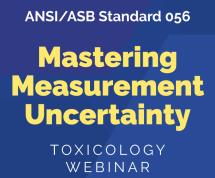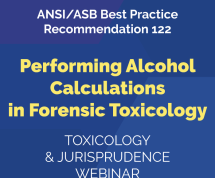Search
Explore content from JFS, ASB, the AAFS Newsfeed, and other content using the search bar or filters.
Technical Report on the Articulation of the Reasoning and Foundational Principles Behind...

Standard for Training and Certification of Canine Detection of Human Remains: Human...


Standard for the Technical Review of Bloodstain Pattern Analysis Reporting

Forensic Toxicology: Terms and Definitions

Terminology for a Suspected Pattern of Dental Origin

Standard for Collection and Preservation of Document Evidence

Assessing the effectiveness of alternate light sources in the search for skeletal remains
Many search and recovery operations for human skeletal remains are unsuccessful due to difficulties recognizing bones in outdoor environments even when evidence indicates the last known whereabouts of missing individuals. Though the collagen component of bone is known to emit flu...
Evaluation of enzyme‐linked immunosorbent assay screening kits for the detection of...
Nitazene analogs are a highly potent class of novel psychoactive substances (NPS) that were first identified in forensic casework in the United States in 2019. While enzyme‐linked immunosorbent assay (ELISA) remains a prevalent screening tool in forensic toxicology laboratories, ...
Evaluation of composition C‐4 odor signature on a novel sorption training aid substrate
The need for reliable non‐detonable training aid systems within explosive canine detection applications is imperative for optimal operational performance. This study utilized Getxent polymer technology for the creation of Composition C‐4 training aid material. The objectives of t...
Correction to “Sickle cell trait in non‐firearm arrest‐related deaths of Black persons”
ASB Newsletter – April 11, 2025
The Hawthorne effect in studies of firearm and toolmark examiners
The Hawthorne effect refers to the tendency of individuals to behave differently when they know they are being studied. In the forensic science domain, concerns have been raised about the "strategic examiner," where the forensic examiner uses different decision threshol...
Exploring female sexual offending with the concepts of hypersexuality and atypical...
Sexual offending is often perceived as predominantly a male behavior. However, due to growing public interest in female criminality, research on female offenders is increasing. Sexual offending can be influenced by various factors, such as hypersexual disorder (HSD), or may be as...
Identifying factors that help improve existing decomposition‐based PMI estimation methods
Accurately assessing the postmortem interval (PMI) remains a challenging task in forensic science. Existing regression models use the decomposition score to predict the PMI or accumulated degree days (ADD) but are often imprecise and rely on small sample sizes. This study explore...

Ricochet of 9‐mm luger bullets off plywood, medium‐density fiberboard, and melamine board:...
Ricochet is the glancing rebound of fired bullets from surfaces and is regularly reported during shooting incidents worldwide. Although existing scientific literature presents many ricochet‐related empirical works in aid of shooting incident reconstructions, studies focusing on c...
Forensic Document Examination Terms and Definitions

Mastering Measurement Uncertainty: From Theory to Practical Application
ANSI/ASB Standard 056 | Like any standard, there are a variety of ways to implement based on the laboratories scope. This webinar will discuss several approaches to implementation and provide helpful tools to ease the process.

ANSI/ASB BPR 122 - Best Practice Recommendations for Performing Alcohol Calculations in Forensic Toxicology
This session will review the pharmacokinetic principles of alcohol as they relate to performing calculations in forensic toxicology casework. The recommendations contained within ANSI/ASB BPR 122 will be discussed and examples will be provided of how to apply those to real-world case scenarios.
